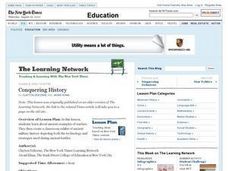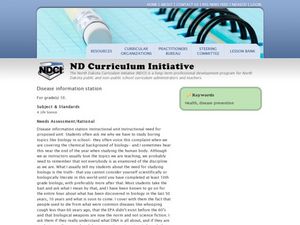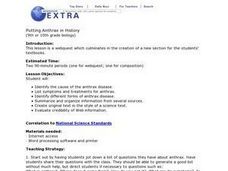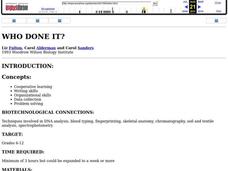Curated OER
The Living Weapon
Learners explore American history, military strategy and scientific discovery near the end of the World War II era. They examine the principles of the Cold War, pacifism, and the desire to keep government programs secret from the...
Curated OER
Plagued by Warfare
Students define "biological weapon" and explore why these types of weapons are so dangerous. They also explore the covert shift of American grant research money to an organization that once directed the Soviet Union's germ warfare...
Curated OER
Weapons of Mass Desctruction in Iraq
Students analyze the chemical and biological weapons of mass destruction that Iraq is accused of having. Students investigate the history and resolutions that have been made regarding bioterrorism.
Curated OER
Anthrax Scare
Students visit the website for the Center of Disease Control. They examine the anthrax page and read through the frequently asked questions. They discuss what needs to be known about the anthrax vaccine and how it is used as a weapon.
Curated OER
Conquering History
Students explore examples of ancient warfare and discuss the various uses of ancient military technologies. Students investigate the origins of biological and chemical weapons and create a classroom exhibit depicting technology and...
Curated OER
Science of War
Tenth graders, from an environmental perspective, study the pros and cons of war. Distinctions between characteristics of biological, chemical and nuclear threats and the impact of economic development are considered.
Curated OER
Anthrax Bioterrorism and Health Care
Students describe the characteristics of anthrax infections, distinguish between the three anthrax forms and analyze the effectiveness of anthrax vaccinations. They relate anthrax to bioterrorism.
Curated OER
Hazard Mitigation: Bioterrorism
Students discuss different ways to spread infectious diseases. In this bioterrorism lesson plan, students model the rate of smoke emission using CalRoad software. They analyze the effects of airborne release of...
Curated OER
Family Life
What is family? Challenge your scholars to write an encompassing definition of what this word means to them. After reading "It May Be a Family Matter, But Just Try to Define Family," class members discuss the emotional issues surrounding...
Curated OER
Handing a Rogue State: North Korea
Students explore the concept of disarmament. For this North Korea lesson, students apply the steps of conflict resolution to the North Korean nuclear crisis as they create flowcharts designed to establish multilateral talks and resolve...
Curated OER
"Who Done It?" Analysis of Molecular Fingerprints Left At the Scene of the Crime
Students examine different types of DNA fragments. They record and analyze their results. They determine who is the criminal in the story.
Curated OER
Lines From Behind the Lines
Fifth graders create a timeline of events in a soldiers life. In this World War I lesson, 5th graders learn about the Great Depression and World War I. Students watch video segments about World War I and examine primary...
Curated OER
Bioterrorism: Development of a "Superbug"
Students compare bacteria and viruses and their roles in biotechnology and bioterrorism. They outline fundamental steps of bacterial transformation and the possible selection processes to identify transformants. They discuss...
Curated OER
From Curiosity Cabinet to Museum Collection
Students study binomial nomenclature and museum-based research. They create a curiosity box, label the objects in their curiosity box , develop a classification scheme for the objects, and create a database of all objects collected by...
Curated OER
EMERGING DISEASES RESEARCH PROJECT
Tenth graders work in teams to gather and present historical as well as current information about an infectious disease. They complete student reports on a Disease Database form for all diseases selected. Students then share their...
Curated OER
Disease Information Station
Tenth graders study disease and how it changes normal body functions. For this research lesson students research a disease and use a word processing software to construct a presentation.
Curated OER
Who Done It?
Pick and choose which activities to include in this crime scene investigation. Junior detectives can examine fingerprints, DNA, blood samples, or bone structure. The plan suggests you have teams solve a mystery, but it does not...
Curated OER
"Role" Call
Students explore the positions of the members of the United Nations Security Council. They stage an enactment of a Council meeting by presenting findings to ambassadors who debate the best course of action.
Curated OER
Putting Anthrax in History
Students identify the cause and symptoms for anthrax. They research information and summarize it into organized ideas. They evaluate the credability of websites as well.
Curated OER
The Reality of War
High schoolers use research materials developed earlier. They synthesize data to formulate an argument for or against war. Students use their notes to address what the possible answers could be.
Curated OER
New words in the dictionary
Students examine how language evolves. They discover that language reflects changes in society. Students guess the meaning of words. In a group activity, students become wordsmiths by inventing new words. Students devise alternative...
Curated OER
Who Done It?
Young scholars work in groups to solve various murder mysteries using DNA evidence to implicate suspects. Teams compete to solve the crimes the fastest, while using various scientific methods to accomplish their task.
PBS
Pbs Online News Hour: Putting Anthrax in History
This instructional activity is a WebQuest which highlights the anthrax attacks of October 2001. Students will be able to identify what anthrax is, list its symptoms and treatments, and identify different forms of the disease.






















